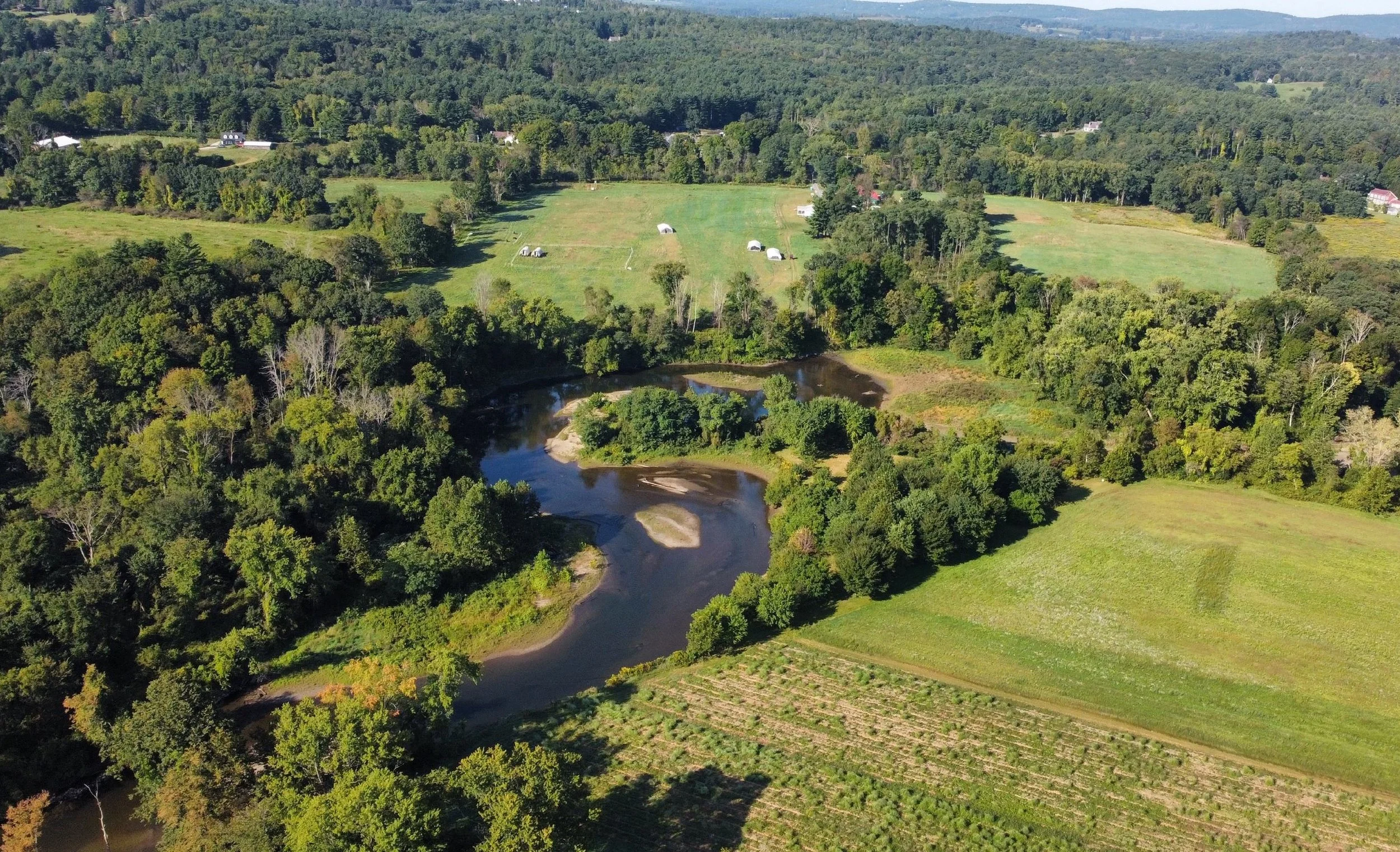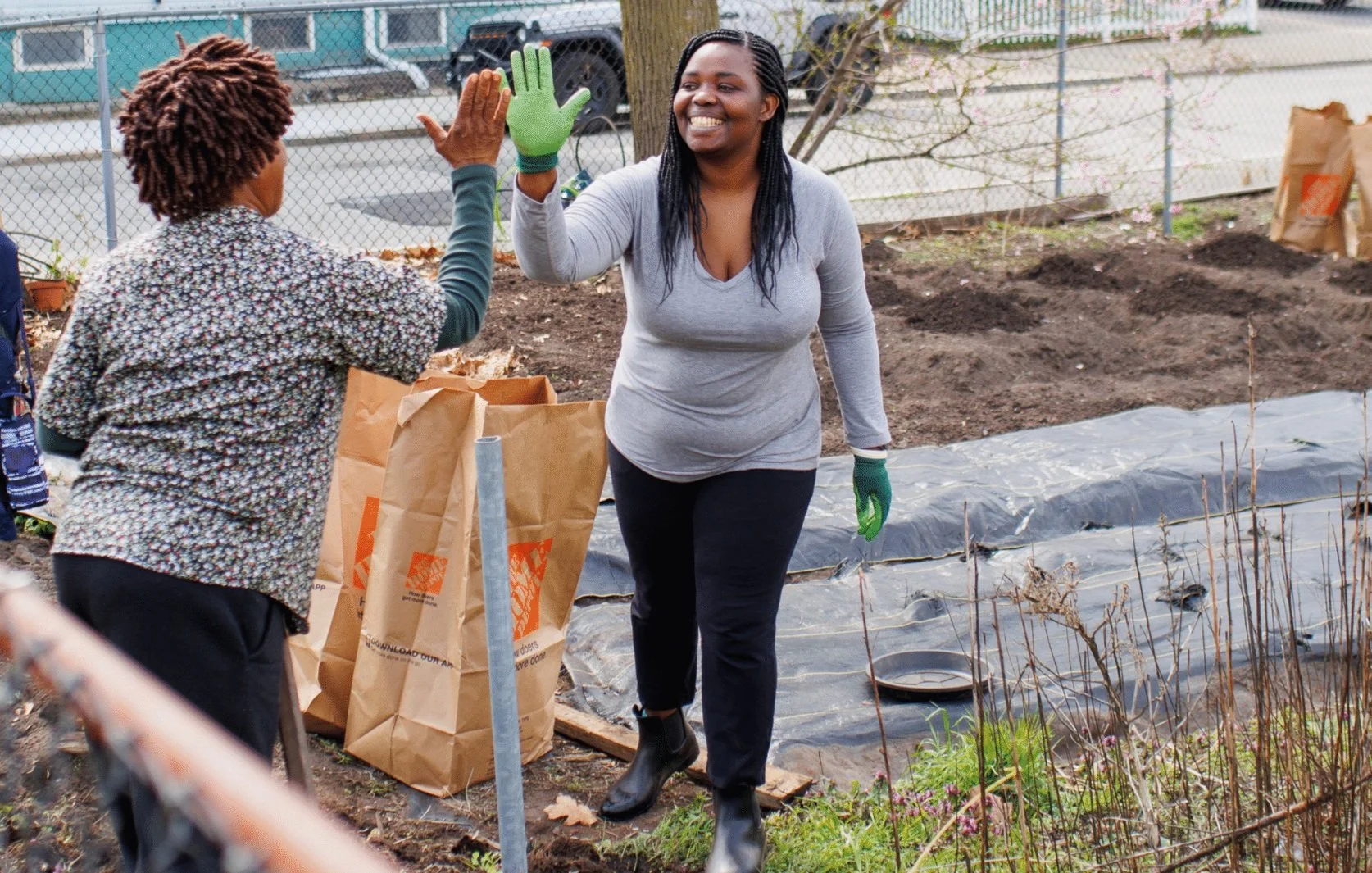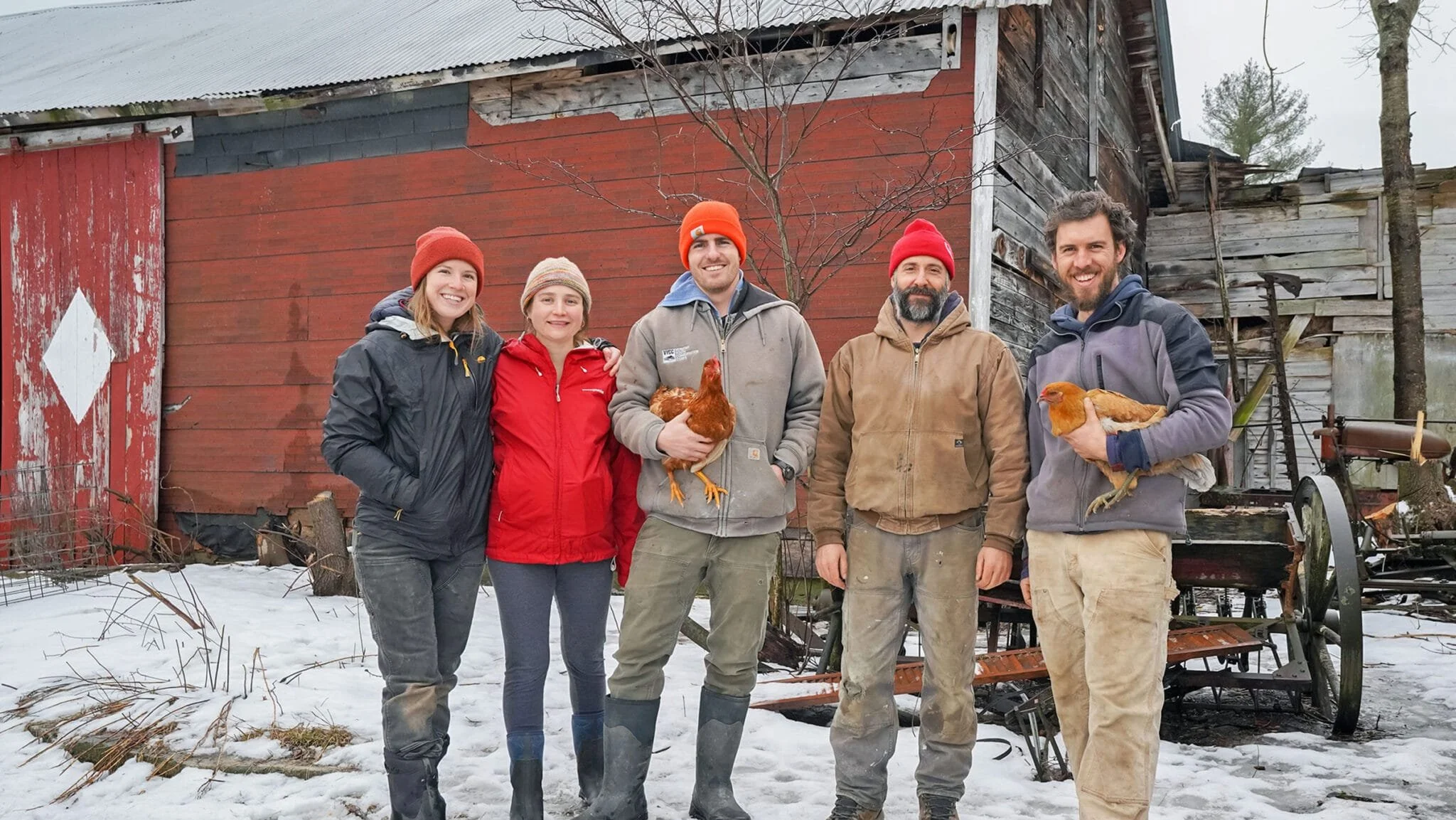Six Pathways to Farmland Access
Models from around New England
If we are to build a food system that thrives in our region, we must forge alternative pathways to support new farmers in accessing land and markets. The economics of small-scale, locally oriented, and ecologically responsible agricultural operations are incompatible with a marketplace defined by extractive production and global supply chains. Identifying and implementing strategies to facilitate this transition, despite the political and economic barriers to success, will require a combination of public policy tools, community support, and sufficient financing to make progress in the face of broader trends of farmland consolidation and conversion.
Here we highlight six unique approaches to land access from each of the six New England states. Innovative work is happening all around us—some thanks to generous donors and insightful policymakers, some resulting solely from good relationships with neighbors. These six profiles are offered to amplify just a few unique approaches that might resonate with you and your community.
Connecticut
Connecting People and Green Spaces in New Haven
Campers at Schooner Summer Camp learn to sail in New Haven Harbor after a day of coastal environmental education. Photo courtesy of Gather New Haven
In addition to making farmland accessible in rural, agricultural communities, pathways to food access can and must be forged in urban spaces as well. In New Haven, a grassroots movement is transforming urban vacant lots and untended parcels into vibrant community gardens and ecological preserves—and, in doing so, is healing far more than the land. In this issue’s interview with Gather New Haven’s Executive Director Jonathón Savage and Development and Community Outreach Manager Zion Jones, we glimpse a vision of greenspace as a catalyst for food access, public health, education, and belonging. From teaching kids to sail in New Haven Harbor to partnering with formerly incarcerated individuals and Indigenous groups, Gather New Haven’s work in collaboration with city officials and local residents is expansive yet rooted. Their approach addresses urgent issues—food insecurity, disconnection from nature, and environmental justice—through simple yet powerful acts: growing food, sharing space with the community, educating youth, and restoring relationships with the land and one another.
Though approximately 90 percent of the growing spaces that Gather New Haven manages are owned by the city of New Haven, and have no significant protection from potential development, the gardens create immeasurable community benefits and opportunity to build alternative food systems from within the downtown core.
Maine
Philanthropy for Farmland Access
Omasombo Katuka is now a land owner, thanks to years of hard work and a mission-aligned investment from the Elmina B. Sewall Foundation. Photo © Ian MacLellan
In 2024, Omasombo Katuka and his family were able to celebrate a major milestone in the development of their farming enterprise; OK Community Farm (OKCF) now has a permanent home. After 10 years of farming on leased land, scattered across four towns and two counties, Katuka successfully purchased a 52-acre farm just 15 minutes from the family’s home in Lewiston, Maine.
With sound financials, a strong connection to local markets, and a demonstrable track record of production and marketing expertise, OKCF had many of the essential elements needed to purchase a farm outright, but finding the right parcel, in the right place, and at the right price proved elusive. Attempts to access federal financing were slow and ultimately unsuccessful, and private funding was unavailable—banks are generally hesitant to offer mortgages on open land for agriculture.
Two notable transactions were key in making the land purchase possible. First, the land had been protected by Maine Farmland Trust through an agricultural conservation easement years ago, reducing the development value of the property on the open market.
Second, OKCF had built a farm intentionally designed to feed community members who struggled with food access. By growing crops familiar to newly arriving West and Central African immigrants and refugees, and leveraging federal and state nutrition incentive programs, OKCF had built a profitable business that simultaneously advanced goals of ending hunger and creating a more welcoming community. This community-minded aspect of OKCF helped establish the farm as a meaningful and tangible effort in alignment with charitable and philanthropic partners. Though OKCF, as a for-profit business, wasn’t eligible for traditional grantmaking opportunities, Katuka’s commitment to a resilient and just local food system proved to be enough for the Elmina B. Sewall Foundation to offer below-market terms on a loan to purchase the property. The Sewall Foundation is in the process of transitioning 100 percent of its assets into alignment with the Foundation’s values by 2028, including allocating $18 million to investments in Maine, and has emphasized the importance of mobilizing all of the organization’s resources, financial and otherwise, to advance their vision for a just, sustainable, and healthy Maine. Beyond the OKCF loan, the Sewall Foundation has recently developed resources and process documents that outline how they offer support to other Farmland Access and Land Return projects around the region.
Mission-aligned investment is hardly a new strategy for New England charitable foundations, with programs like the New Hampshire Community Foundation’s Impact Investment Fund operating under this model for over four decades. A wider shift of foundation endowments toward mission-aligned projects could provide a key source of capital for farmland access and tenure interventions. The Sewall Foundation’s portfolio, as an example, will not see market-rate returns on their loan to OKCF but will see a significantly higher “rate of return” when viewed as an effort toward the foundation’s goals of equitable food access, resilient ecosystems, and expanded racial equity and justice in Maine.
Massachusetts
Community Land Trust Models for Lasting Affordability
The oxbow on the Housatonic at River Run Farm. Photo courtesy of Berkshire Community Land Trust
One key distinction between wilderness conservation and working lands protection is the need to consider future affordability. If the development rights are purchased and extinguished on, say, a wild salt marsh—the job is done. Though ongoing stewardship is needed to ensure the protected resource remains in its natural state, the one-time acquisition of an easement is designed to have lasting impact and value. Contrast this to efforts to protect a working farm: an easement can be purchased and development rights extinguished, but the current landowner will inevitably retire or sell the property, and the future of the land comes into question. Will it remain in active agriculture? Will it become a private hobby farm with a few horses for show? Someone new must step forward to keep the farm in active agricultural production, and this can prove expensive. As land continues to appreciate in value, purchasing that property becomes increasingly out of reach for the majority of new farmers and farm families if care is not taken to ensure the land remains affordable.
In western Massachusetts, the Farmsteads for Farmers project at the Berkshire Community Land Trust (BCLT) is applying lessons and tools developed through the affordable housing community’s work to address the same challenges of ongoing affordability and access. The Community Land Trust (CLT) movement, first established as a tool to help Black families achieve land tenure in the American South, has grown to incorporate nearly 225 projects nationwide that address the ongoing affordability of housing through decommodifying the land and removing its value from the market equation. Farmsteads for Farmers seeks to apply the same framework to agricultural land in the southern Berkshires, addressing barriers to both farmland tenure and housing insecurity for landless farmers.
The CLT model typically includes an organization that buys land and/or buildings. A new tenant usually purchases any infrastructure on the property (a house, farm buildings, etc.) but the land itself is owned by the CLT and leased back to the tenant. Affordability formulas dictate how the home and other improvements on the property will be valued when the tenant moves on. Graphic courtesy of the Parkdale (Toronto) People’s Economy Project
The Farmsteads for Farmers model is best illustrated by the current campaign to secure River Run Farm in Great Barrington. BCLT, collaborating with a generous donor, bought the 79-acre farm along the Housatonic River on the open market for $1.2 million in 2021. After making an additional $400,000 worth of improvements to the farmhouse and existing infrastructure, BCLT partnered with local farmers struggling to find secure land tenure to buy the house and on-farm infrastructure at a price of approximately $200,000, then to enter into a 98-year ground lease, which is inheritable and renewable, for long-term access to the property. BCLT is currently fundraising to cover the $1.4 million difference, and will begin leasing the land to the new farmers at a marginal rate (BCLT also incorporates the value of the farm’s ecosystem service contributions to the local landscape/food system into lease payments). Because the farmers own the infrastructure (the farmhouse, hoop houses, irrigation systems, and perennial crops, and even soil carbon reserves), the current tenants can sell that infrastructure if they decide to leave. Future sale prices are then set by formula, guaranteeing a lower price for future prospective owners.
Though this agricultural spin on the community land trust model is capital-intensive (the CLTs behind the project need access to significant capital support to purchase and hold property in perpetuity), it creates opportunities that truly set farmers up for success. With lifetime tenure on high-quality land in a supportive community, the new owners of River Run Farm have the opportunity to build equity and their business without focusing on debt service.
BCLT Operations Director Beth Carlson shared the motivation behind implementing this model: “This work is complicated. Across the country, people are doing gymnastics trying to put together tax credits, agricultural preservation restrictions, conservation preservation restrictions, easements, whatever—all in order to put farmers on land. And once that’s done, it’s done. You can’t sell the development rights again, so the land is eventually going to be sold and the price is going to go up. This model removes that recurring cycle permanently.”
New Hampshire
Community-owned Resources for Aspiring Farmers
A working farm sits at the literal and figurative center of the Nubanusit Cohousing Project in southern New Hampshire. Photo © Clive Russ, courtesy of Nubanusit Neighborhood and Farm
In 2004, a group of community members seeking a more connected way of living embarked on the development of the Nubanusit Neighborhood and Farm in Peterborough, New Hampshire. The original organizers, and residents who have joined the community over the past 21 years, shared a common interest in building a community that encouraged living and working together to nurture and support each other and to steward the land on which they live. That commitment has, over time, manifested in the development of 29 energy-efficient houses, townhouse units, and condominiums for individuals and families, thoughtfully located to protect the woods and waters of the 113 acres collectively owned by the community.
At the core of the Nubanusit project is a commitment to making connections with and through local food and agriculture. In addition to developing homes for like-minded residents, the community serves as a nurturing home for new and beginning farmers by offering access to eight acres of agricultural land, access to a tractor and farm equipment, and essential infrastructure like cold storage and a seedling greenhouse, all in exchange for responsible stewardship of the farmland. The community also forms an informal, but easily accessible, market opportunity for residents who are excited to support the farm operation in their backyard and give a new business a ready-made customer base. With no lease payments, supportive neighbors, and a head start on marketing, farmers just getting started are able to dedicate their capital and attention to building a strong business as they see fit, rather than building a business as quickly as possible to start paying off a mortgage.
Elsbeth Pendleton-Wheeler and Jasen Woodworth, owners of Nubi River Farm, started their diversified vegetable operation on the cohousing community’s land four years ago and will move to a new property elsewhere in Peterborough in 2026, giving the cohousing community an opportunity to consider inviting a new farmer to take advantage of the assembled resources and excited, supportive community.
Rhode Island
Putting Land to Work for Justice and Equity
Photo courtesy of Southside Community Land Trust
In Rhode Island, the Southside Community Land Trust (SCLT) is powerfully reshaping the way communities access and engage with food. In this issue’s conversation with Southside’s Executive Director Margaret DeVos, land is not a backdrop—it’s the foundation for a more just and resilient food system. As both a land trust and a food systems catalyst, Southside is reclaiming urban and rural parcels across Rhode Island and placing them into permanent community stewardship. The organization doesn’t just acquire land to preserve it—it puts that land to work for people, helping local farmers grow food for their neighbors and build viable livelihoods in the process. In places like Providence, where greenspace is rare and food insecurity is high, Southside supports the SCLT Healthy Food Hub, which provides a central place for farmers from around the state to sell their produce to people who otherwise don’t have access to fresh, locally grown fruits and vegetables.
DeVos reflects on the fact that the areas with affordable land and where food needs are greatest aren’t always the same. Today, even as land values climb—Rhode Island has the highest cost per acre of land in the United States—the organization continues to acquire property, often relying on individual donors and public partners to make it happen. Their model blends the long-term vision of conservation with the immediacy of food justice: land held in trust, not for profit, but for people—especially those historically excluded from ownership and access. “When you bring healthy food into a community,” DeVos says, “things get better.” This interview reveals how conserving land can serve not only the environment but the health, agency, and vitality of communities.
Vermont
Pooling Resources, Sharing Land
Five farmers; two land trusts; staff and programs from local, state, and federal governments; plus an entire community of neighbors and supporters came together to support The Farm Upstream’s new land acquisition. Photo © Kyle Gray, courtesy of Vermont Land Trust
Farmers searching for stable land tenure have to balance many competing factors in finding a suitable home for their operations. Price, proximity to markets, and soil quality are often the major factors, but farmers (like anyone else) also might consider local schools, community politics, or opportunities for off-farm employment as they search for the right home for their farms and families. Chittenden County, Vermont, home to most of the Burlington metropolitan area and over 25 percent of the state’s population, checks most of those boxes for aspiring fruit and vegetable farmers in Vermont as they seek the right blend of agricultural resources and bustling market opportunities. However, demand across Chittenden County is also strong for non-agricultural use; residential and commercial development are also concentrated on the edges of urban centers as cities sprawl outward. Chittenden County outpaced the rest of the state in rising land prices, with a jump of nearly seven percent in the last year alone.
Partially because of the limited availability and high value of farmland in the region, a group of five farmers, now all operating as The Farm Upstream, had struggled to find a suitable home for their vegetable enterprises. Tucker Andrews, Cory Froning, Spencer Hardy, Jacqueline Huettenmoser, and Jake Kornfeld each had farming experience, but they ultimately found success through collaboration, both as farmers and with community partners. A 100-acre farm with good soils, in an agriculture-friendly community located 30 minutes from Burlington, came on the market in 2023 but at a price out of reach of any of the individual farmers. Coming together allowed the growers to pool their time, effort, experience, financial resources, and networks of support to purchase the property by the end of that year—providing the collective with stable land tenure to put down roots and to grow their businesses.
This transfer provides a perfect illustration of the role and importance of agricultural conservation easements in farmland access efforts. Vermont Land Trust and the Jericho Underhill Land Trust, in collaboration with the USDA’s Natural Resource Conservation Service, the Jericho Conservation Reserve Fund, and the Vermont Housing and Conservation Board, purchased an easement to protect 52 acres of high-quality agricultural soils along the Lee River and reduced the final purchase price owed by the farmers by nearly 75 percent. With an affordable purchase, the farmer collaborative retained capital that could instead be invested in the infrastructure required to get their farm up and running.
The five farmers at The Farm Upstream, like other multi-family farm operations around the region, are building a model centered around collective capacity, calling on many hands to find success in a challenging marketplace. The conservation partnerships that emerged to protect this particular parcel have made this model possible.
Alex Redfield is the Policy Director for Wildlands, Woodlands, Farmlands & Communities. On the farm, in state government, and in conservation policy circles, his work for the past 20 years has centered on supporting a just transition of New England’s landscape toward an equitable future. He lives in South Portland, Maine.
Marissa Latshaw works with mission-driven organizations to build empathetic and inclusive communication strategies that inspire action. She is the Publisher of From the Ground Up and Co-coordinator of the Wildlands, Woodlands, Farmlands & Communities initiative, working with partners throughout New England to help bring a more holistic, integrated approach to land conservation. Marissa lives in Connecticut with her family.







